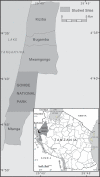Estimating the prevalence and intensity of Schistosoma mansoni infection among rural communities in Western Tanzania: The influence of sampling strategy and statistical approach
- PMID: 28934206
- PMCID: PMC5626504
- DOI: 10.1371/journal.pntd.0005937
Estimating the prevalence and intensity of Schistosoma mansoni infection among rural communities in Western Tanzania: The influence of sampling strategy and statistical approach
Abstract
Background: Schistosoma mansoni is a parasite of major public health importance in developing countries, where it causes a neglected tropical disease known as intestinal schistosomiasis. However, the distribution of the parasite within many endemic regions is currently unknown, which hinders effective control. The purpose of this study was to characterize the prevalence and intensity of infection of S. mansoni in a remote area of western Tanzania.
Methodology/principal findings: Stool samples were collected from 192 children and 147 adults residing in Gombe National Park and four nearby villages. Children were actively sampled in local schools, and adults were sampled passively by voluntary presentation at the local health clinics. The two datasets were therefore analysed separately. Faecal worm egg count (FWEC) data were analysed using negative binomial and zero-inflated negative binomial (ZINB) models with explanatory variables of site, sex, and age. The ZINB models indicated that a substantial proportion of the observed zero FWEC reflected a failure to detect eggs in truly infected individuals, meaning that the estimated true prevalence was much higher than the apparent prevalence as calculated based on the simple proportion of non-zero FWEC. For the passively sampled data from adults, the data were consistent with close to 100% true prevalence of infection. Both the prevalence and intensity of infection differed significantly between sites, but there were no significant associations with sex or age.
Conclusions/significance: Overall, our data suggest a more widespread distribution of S. mansoni in this part of Tanzania than was previously thought. The apparent prevalence estimates substantially under-estimated the true prevalence as determined by the ZINB models, and the two types of sampling strategies also resulted in differing conclusions regarding prevalence of infection. We therefore recommend that future surveillance programmes designed to assess risk factors should use active sampling whenever possible, in order to avoid the self-selection bias associated with passive sampling.
Conflict of interest statement
The authors have declared that no competing interests exist.
Figures



Similar articles
-
Prevalence and intensity of Schistosoma mansoni infection in pediatric populations on antiretroviral therapy in north-western Tanzania: a cross-sectional study.BMJ Open. 2019 Jul 24;9(7):e029749. doi: 10.1136/bmjopen-2019-029749. BMJ Open. 2019. PMID: 31345980 Free PMC article.
-
Co-infection with Schistosoma mansoni and Human Immunodeficiency Virus-1 (HIV-1) among residents of fishing villages of north-western Tanzania.Parasit Vectors. 2014 Dec 16;7:587. doi: 10.1186/s13071-014-0587-2. Parasit Vectors. 2014. PMID: 25511298 Free PMC article.
-
Intestinal schistosomiasis of Ijinga Island, north-western Tanzania: prevalence, intensity of infection, hepatosplenic morbidities and their associated factors.BMC Infect Dis. 2019 Oct 7;19(1):832. doi: 10.1186/s12879-019-4451-z. BMC Infect Dis. 2019. PMID: 31590657 Free PMC article.
-
Intestinal schistosomiasis and geohelminths of Ukara Island, North-Western Tanzania: prevalence, intensity of infection and associated risk factors among school children.Parasit Vectors. 2014 Dec 23;7:612. doi: 10.1186/s13071-014-0612-5. Parasit Vectors. 2014. PMID: 25533267 Free PMC article.
-
Schistosoma mansoni Infection and Its Related Morbidity among Adults Living in Selected Villages of Mara Region, North-Western Tanzania: A Cross-Sectional Exploratory Study.Korean J Parasitol. 2017 Oct;55(5):533-540. doi: 10.3347/kjp.2017.55.5.533. Epub 2017 Oct 31. Korean J Parasitol. 2017. PMID: 29103268 Free PMC article.
Cited by
-
Prevalence, infection intensity and geographical distribution of schistosomiasis among pre-school and school aged children in villages surrounding Lake Nyasa, Tanzania.Sci Rep. 2021 Jan 11;11(1):295. doi: 10.1038/s41598-020-80317-x. Sci Rep. 2021. PMID: 33432079 Free PMC article.
-
Current status of schistosomiasis in school-aged children in Mwanga district, Tanzania: impact of two decades of annual Mass Drug Administration programme.Parasitology. 2024 Sep;151(11):1254-1259. doi: 10.1017/S0031182024001045. Epub 2024 Oct 21. Parasitology. 2024. PMID: 39428848 Free PMC article.
-
Enabling targeted mass drug administration for schistosomiasis in north-western Tanzania: Exploring the use of geostatistical modeling to inform planning at sub-district level.PLoS Negl Trop Dis. 2024 Jan 16;18(1):e0011896. doi: 10.1371/journal.pntd.0011896. eCollection 2024 Jan. PLoS Negl Trop Dis. 2024. PMID: 38227610 Free PMC article.
-
The prevalence of schistosomiasis in Uganda: A nationally representative population estimate to inform control programs and water and sanitation interventions.PLoS Negl Trop Dis. 2019 Aug 14;13(8):e0007617. doi: 10.1371/journal.pntd.0007617. eCollection 2019 Aug. PLoS Negl Trop Dis. 2019. PMID: 31412023 Free PMC article.
-
Gene-Specific Sex Effects on Susceptibility to Infectious Diseases.Front Immunol. 2021 Oct 14;12:712688. doi: 10.3389/fimmu.2021.712688. eCollection 2021. Front Immunol. 2021. PMID: 34721380 Free PMC article. Review.
References
-
- van der Werf MJ, de Vlas SJ, Brooker S, Looman CWN, Nagelkerke NJD, Habbema JDF, et al. Quantification of clinical morbidity associated with schistosome infection in sub-Saharan Africa. Acta Trop. 2003;86(2–3):125–39. - PubMed
-
- Rugemalila JB. Schistosomiasis In: Mwaluko GM, Kilama WL, Mandara MP, Murru M, McPherson CNL, editors. Health and Diseases in Tanzania. New York: Harper Collins Academic Press; 1991. p. 145–58.
-
- WHO. Working to overcome the global impact of neglected tropical diseases: First WHO report on neglected tropical diseases. Geneva: World Health Organization, 2010.
MeSH terms
LinkOut - more resources
Full Text Sources
Other Literature Sources

